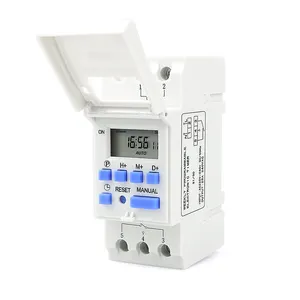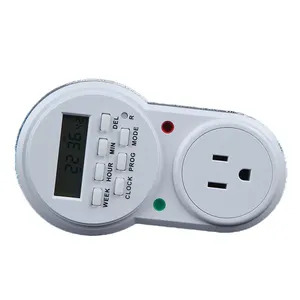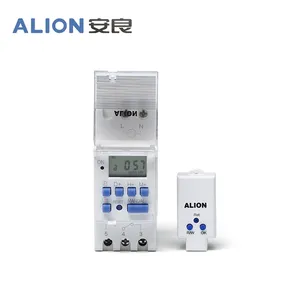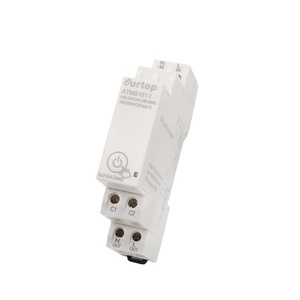(5428 products available)































































































































































































Various 16a timers are available, both digitally and mechanically. Each has unique features and functions that meet different needs.
Mechanical 16a timers
Mechanical 16a timers work with the help of mechanics. They have a round dial that one can rotate to set the time. The internal clock then switches the device on or off at the set time. These timers are simple to use and reliable for basic tasks like controlling lights or heaters.
Digital 16a timers
Digital 16a timers have an LED display and touch buttons for easy operation. They offer more precise time settings and can program multiple on/off cycles for different times of the day. Some digital timers even have features like countdown timers, random settings for security, and backup batteries to keep programs during power outages.
Day timers
As the name suggests, these timers are used only during the day. They are perfect for devices that need to be used daily. They will automatically reset when the day ends.
Weekly timers
Weekly timers can be programmed to operate devices at a specific time and day of the week. They are ideal for appliances that need to be used weekly, such as pool pumps or aquarium feeders.
Sunrise/sunset timers
These timers automatically turn on/off devices based on the sunrise and sunset times. They are perfect for outdoor lighting, irrigation systems, and other applications that depend on daylight hours.
Count timers
Count timers are used in industrial settings. They can count down machine operating hours, track production cycles, or schedule maintenance. They help ensure equipment runs as needed and lasts longer.
Interval timers
Interval timer allows users to set specific intervals for turning devices on and off. They are suitable for applications such as ventilation systems, where equipment needs to operate periodically.
Random timers
Random timers provide a degree of unpredictability by slightly varying the activation/deactivation times. They are commonly used for security systems, such as automated lighting to deter intruders.
Astro timers
Astro timers are advanced timers that automatically adjust based on changes in sunrise and sunset times throughout the year. They are perfect for outdoor lighting in areas with significant seasonal variations.
16a timers come in two main categories: mechanical and digital. Each category has unique features and design elements.
Mechanical timers:
Mechanical timers have a round dial. The numbers on the dial increase in a clockwise manner.
They also have a small switch on the side or back. This switch sets the current time.
The dial has tiny ticks to help users set the time accurately.
Mechanical timers are usually cylindrical or rectangular. They are small and portable.
The casing is often made of plastic or metal. It protects the internal mechanisms.
Mechanical timers use a spring-driven mechanism. It is simple and reliable. No batteries or external power are needed.
Digital timers:
Digital timers have a rectangular or square LCD or LED display. The display shows the time in hours, minutes, and seconds.
They have buttons for setting the time and changing the settings. These include hour, minute, start, stop, and reset buttons.
Some digital timers have touch-sensitive controls. They make them easier to operate.
Digital timers come in various shapes and sizes. They are usually more compact than mechanical timers.
The casing is often made of plastic or metal. It is designed to be durable and easy to clean.
Digital timers use electronic circuits and microprocessors. They are accurate and easy to read.
16a timers are versatile and adaptable gadgets that may be employed in numerous settings. They can be utilized in homes, workplaces, and industries. These timers find application in residential settings by controlling home appliances. For instance, a timer can switch on and off lights and electrical fans. It is also used to switch on decorative lights during festive seasons. It can also be used to manage heating devices, such as electric room heaters, hair straighteners, and curling irons. In gardens, automatic irrigation systems can be used to water plants at set times.
In industrial settings, 16a timers are used for machinery automation. They are employed to schedule the operation of machines and equipment. In process control, timers are used to manage production processes. They are used for timed controls, such as in conveyor belts, mixing operations, and packaging lines. In laboratories, 16a timers are used for experiments. They are used to control the operation of lab equipment. In commercial settings, these timers are used for energy management. They are used to switch off and on air conditioning systems in hotels and restaurants.
In lighting control, 16a timers can turn off and on lights based on preset times. They are particularly useful for outdoor lighting, sign lighting, and security lighting. In agriculture, automatic feeding devices for livestock can be used. In telecommunications, 16a timers are used to control the operation of backup power systems. In medical equipment, these timers are employed to control the operation of devices. They are used in surgical instruments, infusion pumps, and diagnostic machines.
Choosing the right 16a timer switch for a specific application can be challenging due to various factors. Here are some key considerations to help make an informed choice:
Load requirements
Determine the electrical load that the timer switch will control. Ensure that the timer's current rating (16a in this case) is sufficient to handle the load. Consider the inrush current for inductive loads, such as motors or transformers, and choose a timer with an appropriate inrush current rating.
Type of load
Identify the nature of the load being controlled. If the timer will be used for lighting applications, ensure it is compatible with dimmable lights or LED bulbs. For motors or pumps, select a timer that provides proper time-based control without damaging the equipment.
Time setting options
The time-setting options available on the timer should be suitable for the application's requirements. Some timers offer precise minute-by-minute adjustments, while others provide broader daily or weekly cycles. Choose a timer with flexible and easily adjustable time-setting options.
Installation requirements
Consider the installation requirements of the timer switch. Ensure that the device's wiring is compatible with the existing electrical system. Check for any mounting or enclosure requirements to ensure proper installation and protection of the timer.
Environmental considerations
Evaluate the environmental conditions where the timer will be installed. If the timer will be exposed to harsh environments, consider one with an IP rating (Ingress Protection) that protects against dust and water intrusion. It ensures the timer's reliability and longevity in challenging conditions.
Compliance and certifications
Ensure that the 16a timer switch complies with relevant electrical standards and certifications. It ensures the timer's safety, performance, and reliability. Compliance with industry standards also provides assurance of quality and compatibility.
Q1: How can one reset a 16A timer switch?
A1: Resetting a timer switch involves turning off the main power supply. Next, press and hold the reset button for about five seconds. Finally, restore the power supply while still holding the reset button.
Q2: What is the average lifespan of a 16A timer switch?
A2: The average lifespan of a timer switch is about ten years. However, they can last longer or wear out quickly, depending on usage and maintenance.
Q3: Can a 16A timer switch be used outdoors?
A3: Yes, timer switches can be used outdoors. But, users must ensure that the timer switch is waterproof and dustproof.
Q4: Does a timer switch save energy?
A4: Yes, timer switches save energy by turning off devices automatically after a preset period of inactivity. This feature is particularly useful for devices that are not used continuously.
Q5: What is the difference between digital and analog 16A timer switches?
A5: The difference between digital and analog 16A timer switches lies in their time setting methods. To set an analog timer switch, users manually rotate the timer dial. However, a digital timer switch has a digital display with buttons for time setting.
The web search volume for the keyword "16a timer" within the Electrical Equipment & Supplies category shows a significant fluctuation, with an average monthly web search volume of 10. Over the past year, there has been a 100% decrease in web searches, reflecting a stark decline in interest or need for this product.
Analyzing the detailed monthly data, the keyword "16a timer" experienced a web search volume of 10 in December 2023, followed by a complete drop to zero web searches from January 2024 through November 2024. This pattern indicates a sharp decline in user interest or market demand, with no recovery periods noted within the year.
The trend observed can be characterized by a peak in December 2023, followed by a consistent zero web search volume for the subsequent months. This suggests a seasonal peak, possibly influenced by specific end-of-year needs or promotions, which did not sustain into the new year. The absence of web searches for the majority of the year points to either a market saturation, product obsolescence, or a shift towards alternative products or technologies within the industry.